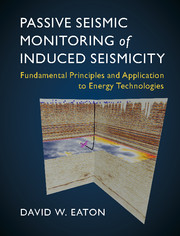 Passive Seismic Monitoring of Induced Seismicity
Passive Seismic Monitoring of Induced Seismicity Book contents
- Frontmatter
- Contents
- Preface
- List of Symbols
- Part I Fundamentals of Passive Seismic Monitoring
- 1 Constitutive Relations and Elastic Deformation
- 2 Failure Criteria and Anelastic Deformation
- 3 Seismic Waves and Sources
- 4 Stress Measurement and Hydraulic Fracturing
- Part II Applications of Passive Seismic Monitoring
- Appendix A Glossary
- Appendix B Signal-Processing Essentials
- Appendix C Data Formats
- References
- Index
3 - Seismic Waves and Sources
from Part I - Fundamentals of Passive Seismic Monitoring
Published online by Cambridge University Press: 07 June 2018
- Frontmatter
- Contents
- Preface
- List of Symbols
- Part I Fundamentals of Passive Seismic Monitoring
- 1 Constitutive Relations and Elastic Deformation
- 2 Failure Criteria and Anelastic Deformation
- 3 Seismic Waves and Sources
- 4 Stress Measurement and Hydraulic Fracturing
- Part II Applications of Passive Seismic Monitoring
- Appendix A Glossary
- Appendix B Signal-Processing Essentials
- Appendix C Data Formats
- References
- Index
Summary
The footsteps of Nature are to be trac'd, not only in her ordinary course, but when she seems to be put to her shifts, to make many doublings and turnings, and to use some kind of art in endeavouring to avoid our discovery.
Robert Hooke (Micrographia, 1665)The point of departure for this chapter is development of a basic mathematical framework for waves that are generated by natural sources, such as earthquakes, or waves that are generated by artificial sources, such as buried explosive charges. Characteristics of the radiated wavefield depend on both the nature of the seismic source, including its geometry, size, kinematics and deformation mechanism, as well as the nature of the medium through which the waves propagate. In general, for an isotropic elastic medium the total wave energy is conserved during propagation. In such a non-attenuating medium, wavefield amplitude diminishes with distance due to the effects of geometrical spreading. Conversely, for an attenuating medium, wave amplitude decays more rapidly due to various dissipation mechanisms. If the medium is anisotropic, wave velocity depends on direction of propagation and polarization of the displacement vector. Moreover, waves in anisotropic media may exhibit certain diagnostic characteristics, such as shear-wave splitting.
The radiation pattern of P and S waves (or qP and qS waves in the case of anisotropic media) depends upon azimuth and inclination of the raypath from the source to the sensor, as well as the source type and orientation. Earthquakes typically produce mode II or mode III shear slip on a fault, but mode I (tensile) rupture processes have also been documented in response to fluid injection and/or volcanic processes. Seismic moment tensors provide a concise mathematical idealization to represent generalized deformation processes that act at a point in the subsurface, in the form of force couples. Unlike classical seismic-wave theory developed in most seismology texts, in this treatment the mathematical framework is developed assuming general anisotropy, from which isotropy emerges as a special case.
Equations of Motion
Consider an elementary volume, bounded by a surface S, within a continuous elastic medium (as depicted in Figure 1.1).
- Type
- Chapter
- Information
- Passive Seismic Monitoring of Induced SeismicityFundamental Principles and Application to Energy Technologies, pp. 51 - 94Publisher: Cambridge University PressPrint publication year: 2018


